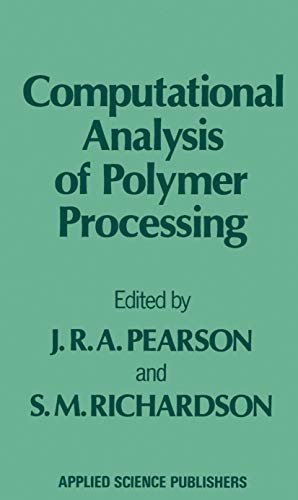computational analysis polymer processing (4 Ergebnisse)
Suchfilter
Produktart
- Alle Product Types
- Bücher (4)
- Magazine & Zeitschriften (Keine weiteren Ergebnisse entsprechen dieser Verfeinerung)
- Comics (Keine weiteren Ergebnisse entsprechen dieser Verfeinerung)
- Noten (Keine weiteren Ergebnisse entsprechen dieser Verfeinerung)
- Kunst, Grafik & Poster (Keine weiteren Ergebnisse entsprechen dieser Verfeinerung)
- Fotografien (Keine weiteren Ergebnisse entsprechen dieser Verfeinerung)
- Karten (Keine weiteren Ergebnisse entsprechen dieser Verfeinerung)
- Manuskripte & Papierantiquitäten (Keine weiteren Ergebnisse entsprechen dieser Verfeinerung)
Zustand Mehr dazu
- Neu (3)
- Wie Neu, Sehr Gut oder Gut Bis Sehr Gut (Keine weiteren Ergebnisse entsprechen dieser Verfeinerung)
- Gut oder Befriedigend (1)
- Ausreichend oder Schlecht (Keine weiteren Ergebnisse entsprechen dieser Verfeinerung)
- Wie beschrieben (Keine weiteren Ergebnisse entsprechen dieser Verfeinerung)
Einband
Weitere Eigenschaften
- Erstausgabe (Keine weiteren Ergebnisse entsprechen dieser Verfeinerung)
- Signiert (Keine weiteren Ergebnisse entsprechen dieser Verfeinerung)
- Schutzumschlag (Keine weiteren Ergebnisse entsprechen dieser Verfeinerung)
- Angebotsfoto (2)
Sprache (1)
Preis
- Beliebiger Preis
- Weniger als EUR 20 (Keine weiteren Ergebnisse entsprechen dieser Verfeinerung)
- EUR 20 bis EUR 45
- Mehr als EUR 45
Gratisversand
Land des Verkäufers
Verkäuferbewertung
-
Computational Analysis of Polymer Processing
Verlag: Applied Science Publishers, 1983
ISBN 10: 0853341885 ISBN 13: 9780853341888
Sprache: Englisch
Anbieter: Zubal-Books, Since 1961, Cleveland, OH, USA
Zustand: Very Good. *FREE DOMESTIC SHIPPING until Monday, Nov. 24* 343 pp., hardcover, previous owner's name to front free endpaper, age-toning to endpapers and pastedowns else very good. - If you are reading this, this item is actually (physically) in our stock and ready for shipment once ordered. We are not bookjackers. Buyer is responsible for any additional duties, taxes, or fees required by recipient's country.
-
Computational Analysis of Polymer Processing
Verlag: Applied Science Publishers, 2013
ISBN 10: 9400966369 ISBN 13: 9789400966369
Sprache: Englisch
Anbieter: Revaluation Books, Exeter, Vereinigtes Königreich
EUR 79,25
EUR 11,37 für den Versand von Vereinigtes Königreich nach USAAnzahl: 2 verfügbar
In den WarenkorbPaperback. Zustand: Brand New. 360 pages. 8.50x5.51x0.82 inches. In Stock.
-
Taschenbuch. Zustand: Neu. Computational Analysis of Polymer Processing | J. R. A. Pearson (u. a.) | Taschenbuch | 343 S. | Englisch | 2011 | Springer | EAN 9789400966369 | Verantwortliche Person für die EU: Springer Verlag GmbH, Tiergartenstr. 17, 69121 Heidelberg, juergen[dot]hartmann[at]springer[dot]com | Anbieter: preigu.
-
Taschenbuch. Zustand: Neu. Druck auf Anfrage Neuware - Printed after ordering - Large, fast, digital computers have been widely used in engineering practice and their use has had a large impact in many fields. Polymer processing is no exception, and there is already a substantial amount of literature describing ways in which processes can be analysed, designed or controlled using the potentialities of modern computers. The emphasis given varies with the application, and most authors tend to quote the results of their calculations rather than describing in any detail the way the calculations were undertaken or the difficulties experienced in carrying them out. We aim to give here as useful and connected an account as we can of a wide class of applications, for the benefit of scientists and engineers who find themselves working on polymer processing problems and feel the need to undertake such calculations. The major application we have in mind is the simulation of the dynamics ofthe various physical phenomena which arise in a polymer process treated as a complex engineering system. This requires that the system be reasonably well represented by a limited number of relatively simple subprocesses whose connections can be clearly identified, that the domi nant physical effects relevant to each subprocess can be well defined in a suitable mathematical form and that the sets of equations and boundary conditions developed to describe the whole system can be successfully discretised and solved numerically.





